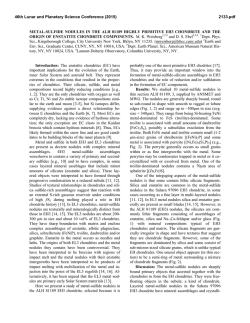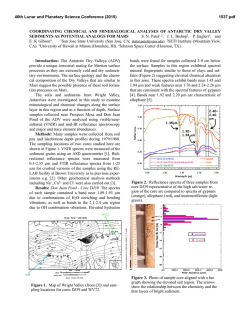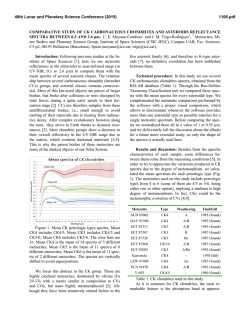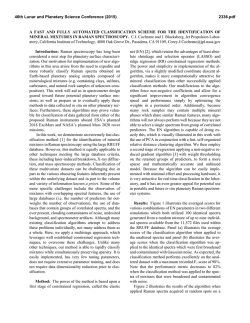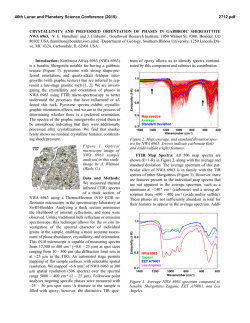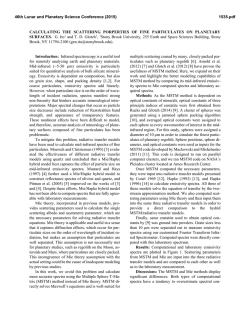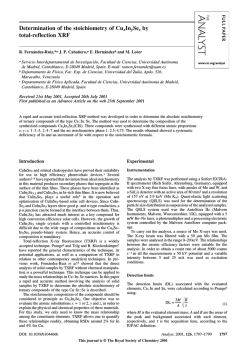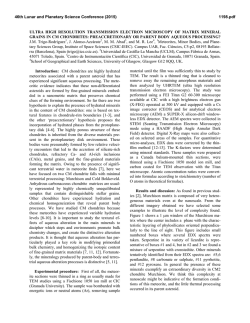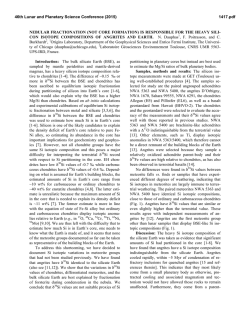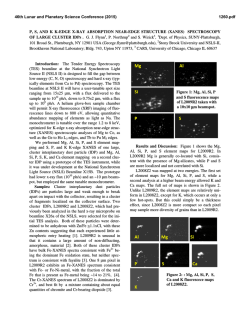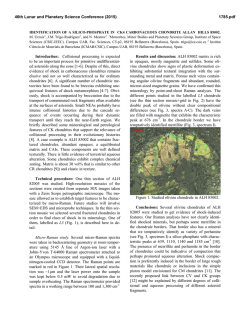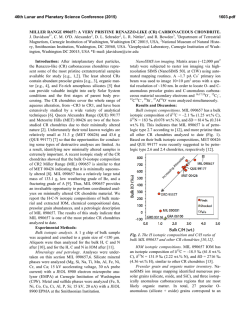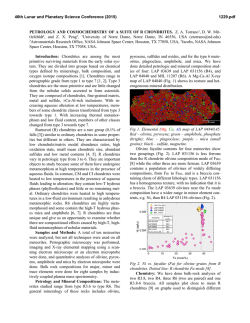
Variable Titanium Oxidation States in Fassaites in Refractory
46th Lunar and Planetary Science Conference (2015) 2252.pdf Variable Titanium Oxidation States in Fassaites in Refractory Nodules from an IDP of Probable Cometary Origin. D. J. Joswiak and D. E. Brownlee, University of Washington, Dept. of Astronomy, Seattle WA 98195 [email protected] Introduction: Investigations of particles from comet Wild 2 and a giant cluster interplanetary dust particle (U220GCA) of probable cometary origin have revealed the presence of refractory-rich grains[1,2,3]. However, unlike chondrites, the examined comet particles do not contain the most refractory-rich materials such as type A CAIs or spinelhibonite-rich inclusions nor are the most refractory minerals such as corundum, hibonite or grossite observed. Based on mineralogy and bulk chemical compositions, refractory comet materials appear to be composed of only low to moderate temperature refractory grains including ‘type C equivalent’ calcium aluminum-rich inclusions (CAIs), aluminum-rich chondrules (ARCs) and amoeboid olivine aggregates (AOAs) [2,3]. The reason that comets do not contain the highest temperature refractory materials is at present unclear but may indicate selective sampling of some nebular reservoirs, preferential transport to the Kuiper Belt of low to moderate temperature nebular condensation products or underrepresentation in the present sample set of the actual populations of refractory materials in comets themselves. We have begun a study of the Ti oxidation states of fassaites from the refractory grains in comet Wild 2 and U220GCA to help shed light on the origins of refractory comet grains and to compare them with chondrites. Measurements of Ti oxidation states provide information on the oxygen fugacities in which the comet grains formed and give evidence whether refractory materials in comets are related to equivalent materials in chondrites. Here we present the initial results of Ti valence studies of fassaites in refractory spinel-anorthiteAl,Ti diopside nodules from a single particle in U2-20GCA using electron energy loss spectroscopy (EELS) combined with transmission electron microscopy (TEM). The Ti valence states of the fassaites are estimated from electron energy-loss near edge structures (ELNES) referenced to Ti oxides of known valence states [4-6]. Samples and Methods: A ~12 µm transparent particle (P6-14) was hand-picked from the anhydrous cluster IDP (U220GCA) which was composed of thousands of submicron to >30 µm particles that “pancaked” over a >400 µm region on the collector flag during stratospheric collection. The fragile nature of the giant cluster particle, its unequilibrated minerals, high abundance of carbon, similarity of the Cr and Mn contents of olivines with Wild 2 olivines [7, unpublished data] and noble gas data (see Pepin et al., this conference) are consistent with a cometary origin. Particle P6-14 was mounted in an acrylic resin cylinder and partially ultramicrotomed to <70 nm sections. The electron-transparent microtome sections were examined with a 200 keV Tecnai TF20 scanning transmission electron microscope equipped with an EDAX light element Xray analyzer, high resolution CCD for bright- and dark-field imaging and a Gatan electron energy loss spectrometer. EELS spectra on <1µm fassaites were collected in diffraction mode around the Ti L3,2 edges (~450-470 eV) with an energy dispersion of 0.1 eV/channel and zero-loss peak resolution of ~0.9 eV. Because of energy drift during spectral aquisitions, all Ti ELNES spectra were collected simultaneously with V L3,2 edges which have fixed energy positions. This was done by placing a TEM grid with a V-coated C-film in the TEM holder directly below the grid containing the IDP microtome sections. The V thin-film was prepared by evaporating ~7nm of V metal directly onto a TEM grid supporting a carbon thin-film. The vanadium peaks, which are present at ~60 eV higher energy than the Ti edges, were used to precisely position the Ti L3,2 ELNES spectra for direct comparison to one another. Background subtraction and plural scattering corrections were applied to all spectra. The corrected spectra were then compared to TiO2 [Ti3+/(Ti3+ + Ti4+) = 0.0] and Ti2O3 [Ti3+/(Ti3+ + Ti4+) = 1.0] oxide standards to estimate the Ti3+/Ti4+ ratios in the P6-14 fassaites. The onset of the Ti L3,2 edges shift ~1.7 – 2.0 eV toward lower energy per oxidation state [6] thus the energy positions of the L3,2 edges in the ELNES spectra in the fassaites indicate the relative abundances of Ti3+ and Ti4+ in these minerals. The Ti3+/Ti4+ fassaite quantification will be performed at a later date. Results: TEM examination of P6-14 reveals that it is a relatively porous aggregate composed of at least seven ~1-5 µm spinel-anorthite-diopside/fassaite nodules and finegrained matrix (Fig 1). The more refractory minerals melilite, perovskite and hibonite were not observed. Anorthite (An9698) generally occupies the interior of each nodule and in many nodules encloses submicron Cr-bearing Mg-Al spinels. Al-Ti diopside/fassaite (Al2O3 = 1.1 - 28.7 wt%; TiO2 = 0.0 - 22.0 wt%) occurs in grains along the exteriors of the anorthites. Continuous to discontinuous rims of En99.5 and occasional Fo99.8, up to 0.5 µm in thickness, enclose the nodules. Tennanometer Ti,V-rich inclusions, believed to be the mineral osbornite, are observed in the anorthites and are similar to those found in the CAI Inti in Stardust track 25 [1]. Ti ELNES spectra were obtained from fassaites in several nodules from two microtome sections. The fassaite spectra (magenta) are shown in Fig. 2 with TiO2 and Ti2O3 reference standards (black) which are composed of 100% Ti4+ and 100% Ti3+, respectively. The near edge structures (“white lines”) result from molecular orbital transitions from 2p to empty 3d levels and have previously been characterized in detail [6]. Rutile (TiO2-all Ti4+) displays 4 dominant peaks composed of two doublets (L3 and L2 edges) whereas Ti2O3 (all Ti3+) is composed of only 2 major peaks, however the peaks are shifted ~2 eV toward lower energy. Comparison of the fassaite spectra obtained from nodules 2 and 3 (Fig. 2) shows that two spectra (A and B) are very similar to the TiO2 standard and therefore the Ti present in these fassaites is believed to be dominated by Ti4+. EELS C, D and E spectra from fassaites from nodules 3 and 7 are more similar to the Ti2O3 standard as these spectra are dominated by only two major peaks and are located at lower energies compared to the EELS A and B spectra, therefore the Ti in these fassaites is believed to have a large Ti3+ component but likely contains both Ti3+ and Ti4+. Discussion: The moderately refractory mineral assemblage and ~concentric monomineralic layers of the nodules which aggregated to form IDP P6-14 are consistent with a nebular condensation origin. Enstatite whiskers and LIME forsterites present within the IDP are also probable nebular condensates [8,9]. The similar sizes of the nodules, their presence in a single IDP, their nearly identical mineralogy and ~concentric textures all indicate the nodules likely formed within the nebula in close proximity to one another as it is unlikely to aggregate such similar materials from wide-ranging nebular 46th Lunar and Planetary Science Conference (2015) locales. The lack of melilite along with the small nodule sizes (high surface/volume ratios) may indicate complete conversion of melilite (perhaps with spinel) with Mg- and Si-rich nebular gas to form anorthite and pyroxene [10]. The presence of Ti in the pyroxenes suggests that a higher temperature Tirich phase such as hibonite or perovskite was also present prior to the lower temperature alteration. Prominent enstatite +/forsterite rims on the nodules may have formed as accretionary rims or as nebular condensation products. The P6-14 nodules are mineralogically, texturally and chemically similar to some fine-grained spinel-rich inclusions in reduced CV3 chondrites [11] and small fine-grained CAIs associated with AOAs in carbonaceous chondrites [12]. In both cases, these materials were interpreted to have originated as high temperature condensation products in the nebula which subsequently reacted with lower temperature gas to form the existing assemblages. Like P6-14, forsterite is occasionally observed in the fine-grained spinel-rich inclusions while both forsterite and low-Ca pyroxenes are present in the AOA/fine-grained CAI assemblages. The Ti ELNES fassaite spectra (Fig 2) show the variable Ti oxidation states of fassaites within and between nodules. EELS-A fassaite clearly formed under oxidizing conditions whereas EELS-C fassaite, from the same nodule, contains significant Ti3+ and therefore is much more reduced. Because it is likely that the nodules formed in a relatively restricted region in the nebula this suggests highly variable localized or rapidly changing ƒO2 conditions. This is in contrast to the comet Wild 2 CAI Inti, which is composed of similar mineralogy and textures as P6-14, but whose fassaites were found Fig. 1 Mg Al Ca P6-14 2252.pdf to have relatively uniform Ti3+/Ti4+ ratios [13]. In Leoville, a reduced CV3 chondrite, significantly lower Ti3+/Ti4+ ratios were found in fassaites in Wark-Lovering rims compared to Al,Ti pyroxenes in CAI interiors indicating a rapid increase in oxidation conditions in the nebular environment [14,15]. Conclusions: Refractory nodules in a ~12 µm particle from a probable cometary IDP are composed of anorthite-diopside/fassaite+/-spinel and have rims of enstatite and forsterite. This mineral assemblage and ~concentric textures suggests condensation at low to moderate refractory temperatues in the solar nebula. EELS spectra of Ti near-edge structures within fassaites in the nodules indicate a range of Ti valence states from highly oxidizing to reducing. These observations indicate that the refractory nodules in IDP P6-14 formed in a region in the solar nebula with pronounced temporal or spatial variations in ƒO2 similar to some CAIs in CV3 chondrites. References: [1] Simon et al. (2008) MAPS 43: 1861-1877. [2] Joswiak D. J. and Brownlee D. E. (2014) 45th LPSC, abstract #2282. [3] Joswiak et al. (2013) 76th Met. Soc. Meeting, abstract #5136. [4] de Groot et al. (1992) Physics Chem. Minerals 19: 140-147. [5] Garvie L. A. J. and Craven A. J. (1994) Amer. Mineral. 79: 411-425. [6] Stoyanov et al. (2007) Amer. Mineral. 92: 577-586. [7] Frank et al. (2014) GCA 142: 240259. [8] Bradley et al. (1983) Nature 301: 473-477. [9] Klöck et al. (1989) Nature 339: 126-128. [10] Beckett and Grossman (1988) EPSL 89: 1-14. [11] Krot et al. (2004) MAPS 39: 15171553. [12] Krot et al. (2004) Chem. Erde Geochim. 64: 185239. [13] Chi et al. (2009) GCA 73: 7150-7161. [14] Simon J. I. et al. (2005) EPSL 238: 272-283. [15] Dyl et al. (2011) GCA 75: 937-949. Spinel 4 L3 An97-98 5 Diop/Fass TiO2 Ti4+ En99+ /Fo99+ 1 3 E L2 Fig. 2 A 6 A B C C B 7 D 2 1 µm E D 6Ti 3+ Ti2O3 Figure captions: Fig. 1) RGB color map from microtome section of a ~12 µm giant cluster IDP showing 7 distinct spinel-anorthiteAl,Ti-diopside nodules with Fo and En rims with fine-grained matrix. Lettered solid circles show locations where Ti ELNES fassaite spectra were obtained and correspond to lettered Ti ELNES spectra in Fig. 2. EELS-D and -E (solid yellow circles) spectra were obtained from indicated nodules from an adjacent microtomed slice (not shown). Fig. 2) EELS spectra around Ti edges in fassaites (A-E) in three nodules (magenta) shown in Fig. 1 compared to Ti4+ and Ti3+ oxide standards (top and bottom spectra). The valence states of the fassaites show substantial variability ranging from nearly all Ti4+ (A and B) to significant Ti3+ (C, D and E) indicating formation in different ƒO2 conditions. An energy range of ~450 – 470 eV is represented on the horizontal axis.
© Copyright 2025
